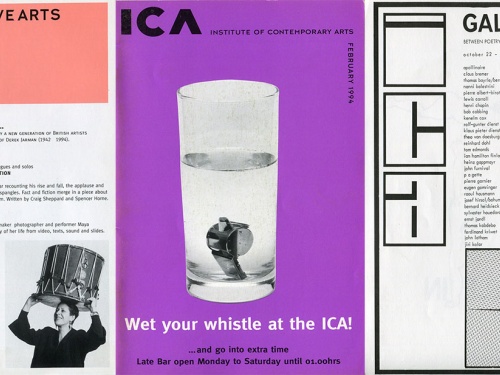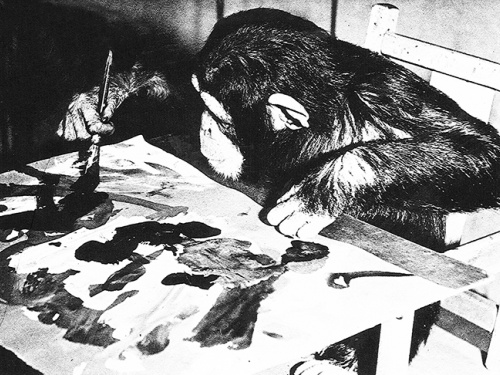Archival Reflections: Art Into Society
Gabrielle Schwarz reflects on our Art Into Society - Society Into Art exhibition, and explores the fragmentary nature of the archive.
Over the past few years, people interested in art—whether as art historians, curators, or visitors to museums and galleries—have become increasingly occupied with a new topic: the history of exhibitions. This is reflected in essays and books such as the ICA’s own publication Institute of Contemporary Arts: 1946–1968.
Recently, visitors to the ICA have been invited to explore the history of exhibitions with a series of shows looking back at significant exhibitions from the ICA’s past, for example, Richard Hamilton at the ICA and FB55, a look back at Francis Bacon’s solo show in 1955. Currently in the ICA Fox Reading Room, visitors can see Art into Society – Society into Art , an archival display about a show that was held at the ICA from 30 October–24 November 1974: Art into Society – Society into Art: Seven German Artists, featuring important politically-engaged artists including Joseph Beuys, Hans Haacke and Gustav Metzger.
The original Art into Society - Society into Art provides an interesting example of how exhibitions challenge our attempts to remember them. The artists and curators wanted to confront the dominant model of art as a commodity to be passively consumed. Their alternative model emphasised active participation and social engagement through art, reflecting this through the exhibition’s format. There were colloquia, public performances and debates, and throughout much of the exhibition Joseph Beuys stayed in the gallery space interacting with visitors.
As with many exhibitions, Art into Society - Society into Art seems to resist being frozen in time and preserved as a single, complete entity. As art curator Hans Ulrich Obrist once put it: "the exhibition has a major archival problem, because the exhibition itself generates archives, but is in its essence ephemeral". Moreover, as sites of individual experiences in space and time, exhibitions produce multiple memories, leading to archives made up of fragments of documentation that each reveal a new perspective on the same show. This is reflected in the range of different types of documents and objects on display currently in the ICA Fox Reading Room, which has been transformed into a temporary public archive where visitors can immerse themselves in, and open up, the past. Below is a selection of the most distinct categories on display.
One key element is text written by the 1974 exhibition organisers and artists, copies of which are available for visitors to read. This includes the exhibition press release and catalogue, as well as related publications: the catalogue for a 1973 German exhibition on art and politics that featured many of the same artists and provided the inspiration for the ICA exhibition, and an issue of Studio International Journal of Modern Art on the topic of Art & Social Purpose, again with writing by many of those involved in Art into Society - Society into Art. These texts develop the exhibition’s intellectual themes, from initial conception to public distribution and later reflection.
However, these texts can only tell; exhibitions show. Throughout the display, an abundance of contact sheets and photographic prints depict the exhibition installation and opening. These are filled with people: putting the exhibition together, socialising at its opening, interacting with the art. They challenge traditional notions of how an exhibition installation shot should look: static, clean, empty of human figures (See Brian O’Doherty’s 1976 series of essays, Inside the White Cube, for more on the tradition of the art installation shot). They remind us that exhibitions are not just containers for art, but sites of human engagement with objects, other people and ideas.
At the centre of the Reading Room visitors can watch interviews with Sir Norman Rosenthal (curator) and Gustav Metzger (artist), providing first-hand accounts from the perspective of two intensely involved individuals with a deep, exclusive knowledge of the exhibition’s evolution.
Finally, right by the exit (or entrance) is a pinboard, displaying a selection of reviews and articles. These provide another first-hand description of the exhibition’s contents, this time from the perspective of its audience rather than its organisers. They also place the show in its social context, relating it to other exhibitions, events and scandals that were taking place, and responding to it in a way that reflects the attitudes and ideas of the time.
There may be no single complete memory of the exhibition which defines its place in a history of exhibitions. However, as the archival display of Art into Society- Society into Art demonstrates, exhibitions do generate an extensive and wide-ranging amount of memories, each revealing their own fascinating perspective on significant moments from the past. ■
Art Into Society - Society Into Art runs 19 January - 13 March.
This article is posted in: Articles, Blog, Exhibitions
Tagged with: Art Into Society - Society Into Art, From the Archive, Gabrielle Schwarz, ICA Archive, Archive, ICA 70, Joseph Beuys, Gustav Metzger, Hans Haacke
%2c_ICA%2c_1974._Photography_%c2%a9_Gerald_Incandela/index.jpg)










